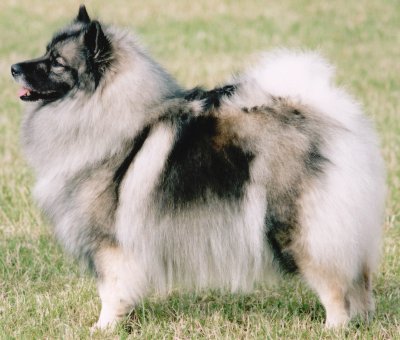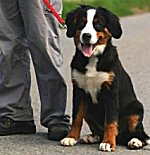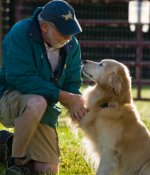Keeshonds: What's Good About 'Em, What's Bad About 'Em
Keeshond temperament, personality, training, behavior, pros and cons, advice, and information, by Michele Welton, Dog Trainer, Behavioral Consultant, Author of 15 Dog Books

Compared to other breeds in the "spitz" family, the Keeshond is quieter, more sensible, and less dominant.
Bright, cheerful, and lively, the Keeshond needs moderate exercise, but more importantly, he needs companionship. He is very people-oriented, craves attention and petting, and needs to be fully involved in the family.
Attitude toward strangers varies from friendly to polite. There is timidity in some lines, so early socialization is important to build an outgoing, confident temperament.
With his acute hearing and emotional sensitivity, Keeshonds are more reactive to loud noises than some other breeds and don't do well in an environment with tension or shouting.
This is not a guard dog. Keeshonds will bark, but it's usually welcoming rather than protective. Most are peaceful with other pets.
The Keeshond has an independent streak and can be mischievous and "clever" (using his intelligence to get his own way). For training, focus on praise, food rewards, and gentle, fair corrections.
The Kees is known as the "Smiling Dutchman" because of his tendency to curl his lip and bare his teeth in a hideous grimace. This is NOT a snarl, but only a happy and submissive grin.
If you want a dog who...
- Is a medium-sized "spitz" (prick ears, curled tail, and thick coat)
- Is easier to live with (less dominant, less mischievous) than most other spitzes
- Needs only moderate exercise
- Is polite with strangers
- Is peaceful with other pets
A Keeshond may be right for you.
If you don't want to deal with...
- "Separation anxiety" (destructiveness and barking) when left alone too much
- Suspiciousness or timidity when not socialized enough
- Stubbornness (mind of his own)
- Potential for excessive barking
- A good amount of regular brushing and combing
- Heavy shedding
A Keeshond may not be right for you.
 |
Dog Breed Traits – Which Traits Are Right For You? In this brand new series, I'll help you decide which dog breed traits would best suit you and your family, your home and yard, and your lifestyle, so you can choose the best dog breed for your family. |
Keep in mind that the inheritance of temperament is less predictable than the inheritance of physical traits such as size or shedding. Temperament and behavior are also shaped by raising and training.
FREE eBooks by Michele Welton
![]() "Respect Training for Puppies" and "Teach Your Dog 100 English Words" are free step by step guides to teaching your pup to be calm and well-behaved.
"Respect Training for Puppies" and "Teach Your Dog 100 English Words" are free step by step guides to teaching your pup to be calm and well-behaved.
![]() "11 Things You Must Do Right To Keep Your Dog Healthy and Happy" is a free guide to keeping your dog mentally, physically, and emotionally happy and healthy so you can enjoy a longer lifetime of companionship.
"11 Things You Must Do Right To Keep Your Dog Healthy and Happy" is a free guide to keeping your dog mentally, physically, and emotionally happy and healthy so you can enjoy a longer lifetime of companionship.

- You can avoid some negative traits by choosing an ADULT dog from an animal shelter or rescue group. With an adult dog, you can easily see what you're getting, and plenty of adult Keeshonds have already proven themselves not to have negative characteristics.
- If you want a puppy, you can avoid some negative traits by choosing the right breeder and the right puppy.
More traits and characteristics of the Keeshond
If I was considering a Keeshond, I would be most concerned about...
- Barking. Keeshonds make keen watchdogs, but that means they are often too quick to sound the alarm at every new sight and sound. You have to be equally quick to stop them. To make matters worse, some Keeshonds have high-pitched barks that can set your teeth on edge.
- Grooming. Keeshonds need frequent brushing and combing so that they don't become a matted mess.
- Heavy shedding. Like all spitz breeds, Keeshonds shed a LOT. You'll find hair and fur all over your clothing and furnishings.
- Separation anxiety. More than most other breeds, Keeshonds need a great deal of companionship and do not like being left alone for more than a few hours. They tend to express their unhappiness through destructive chewing and barking.
- Providing enough socialization. Keeshonds tend to be a bit standoffish with strangers. So they need extensive exposure to people and to unusual sights and sounds, so that their natural caution doesn't become shyness or suspiciousness.
- Mind of their own. Keeshonds are more willing to listen to you than some other spitzes. Yet they still have an independent mind of their own and can be stubborn and manipulative. You must show them, through absolute consistency, that you mean what you say. Follow my free online training programs.
My best-selling books – now available FREE on my website
 Respect Training For Puppies: 30 seconds to a calm, polite, well-behaved puppy is for puppies 2 to 18 months old. Your puppy will learn the 21 skills that all family dogs need to know. Click here to read for free.
Respect Training For Puppies: 30 seconds to a calm, polite, well-behaved puppy is for puppies 2 to 18 months old. Your puppy will learn the 21 skills that all family dogs need to know. Click here to read for free. Teach Your Dog 100 English Words is a unique Vocabulary and Respect Training Program that will teach your adult dog to listen to you and do what you say. Click here to read for free.
Teach Your Dog 100 English Words is a unique Vocabulary and Respect Training Program that will teach your adult dog to listen to you and do what you say. Click here to read for free. 11 Things You Must Do Right To Keep Your Dog Healthy and Happy helps your dog live a longer, healthier life. Get my honest advice about all 11 Things before you bring home your new puppy, because some mistakes with early health care cannot be undone. Click here to read for free.
11 Things You Must Do Right To Keep Your Dog Healthy and Happy helps your dog live a longer, healthier life. Get my honest advice about all 11 Things before you bring home your new puppy, because some mistakes with early health care cannot be undone. Click here to read for free.Related posts you might enjoy






